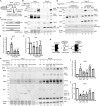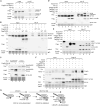Deltex and RING-UIM E3 ligases cooperate to create a ubiquitin-ADP-ribose hybrid mark on tankyrase, promoting its stabilization
- PMID: 40901936
- PMCID: PMC12407064
- DOI: 10.1126/sciadv.adx7172
Deltex and RING-UIM E3 ligases cooperate to create a ubiquitin-ADP-ribose hybrid mark on tankyrase, promoting its stabilization
Abstract
ADP-ribosylation can occur as mono-ADP-ribose (MAR) or be extended into poly-ADP-ribose (PAR). Tankyrase, a PAR transferase, adds PAR to itself and other proteins targeting them for proteasomal degradation via the PAR-binding E3 ligase RNF146. This degradation can be counteracted by RING-UIM E3 ligases RNF114 and RNF166, although the process is unclear. Here, we identify a mechanism that can regulate the balance between MAR and PAR on tankyrase to control degradation. We show that Deltex E3 ligases DTX2 and DTX3 catalyze monoubiquitylation of tankyrase in cells. This ubiquitylation occurs, not on a (canonical) lysine, but rather on MAR, creating a monoubiquitin-MAR hybrid mark. RNF114 and RNF166 recognize this mark using a unique hybrid reader domain and further diubiquitylate it. This ubiquitylation of MAR, which occurs near the ADP-ribose addition site, prevents PAR formation, antagonizing the action of the PAR-binding E3 ligase RNF146 and stabilizing tankyrase. These findings reveal an interplay between ubiquitin, ADP-ribose, and E3 ligases in cellular signaling.
Figures






References
-
- Luscher B., Ahel I., Altmeyer M., Ashworth A., Bai P., Chang P., Cohen M., Corda D., Dantzer F., Daugherty M. D., Dawson T. M., Dawson V. L., Deindl S., Fehr A. R., Feijs K. L. H., Filippov D. V., Gagne J. P., Grimaldi G., Guettler S., Hoch N. C., Hottiger M. O., Korn P., Kraus W. L., Ladurner A., Lehtio L., Leung A. K. L., Lord C. J., Mangerich A., Matic I., Matthews J., Moldovan G. L., Moss J., Natoli G., Nielsen M. L., Niepel M., Nolte F., Pascal J., Paschal B. M., Pawlowski K., Poirier G. G., Smith S., Timinszky G., Wang Z. Q., Yelamos J., Yu X., Zaja R., Ziegler M., ADP-ribosyltransferases, an update on function and nomenclature. FEBS J. 289, 7399–7410 (2021). - PMC - PubMed
-
- Jessop M., Broadway B. J., Miller K., Guettler S., Regulation of PARP1/2 and the tankyrases: Emerging parallels. Biochem. J. 481, 1097–1123 (2024). - PubMed
MeSH terms
Substances
Grants and funding
LinkOut - more resources
Full Text Sources

